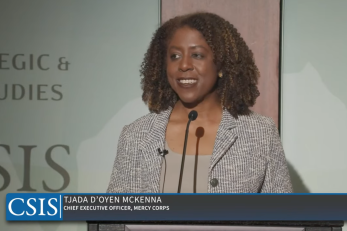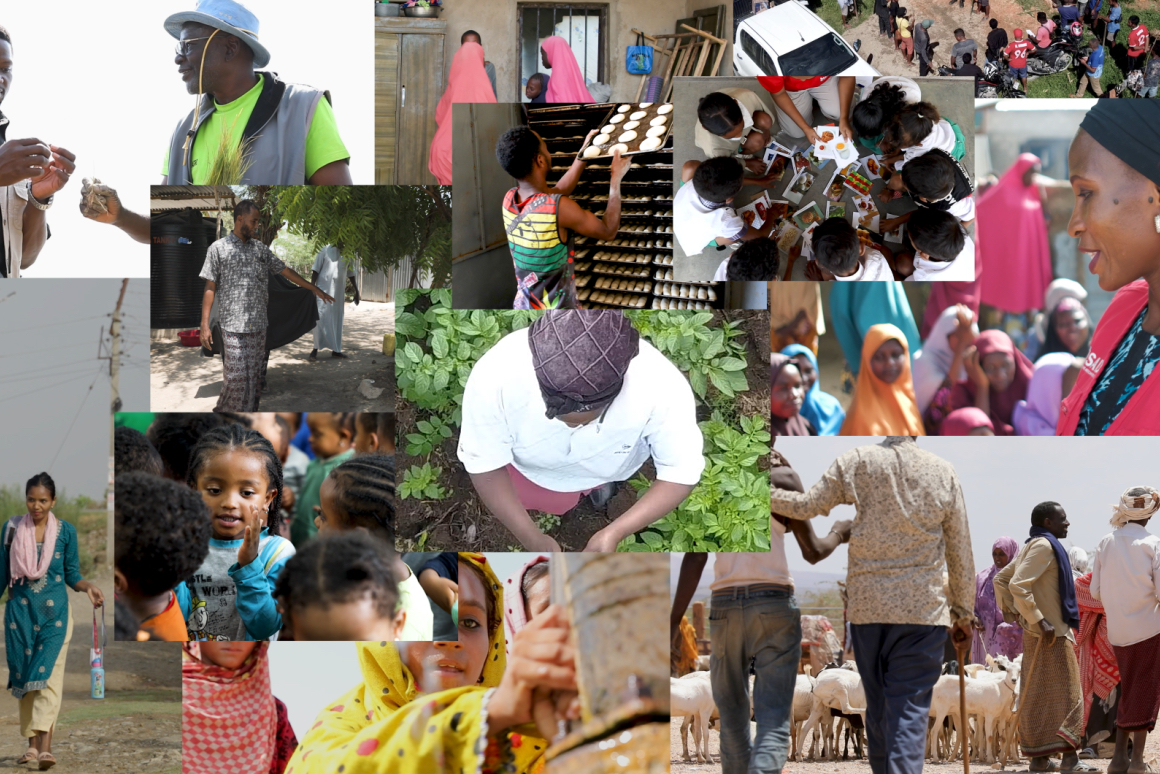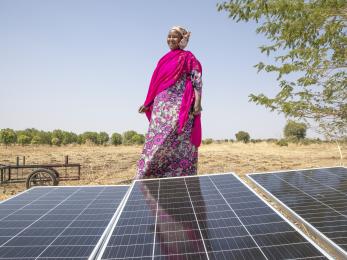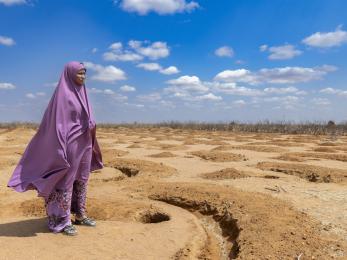Mercy Corps CEO on the need to address “the vicious cycle of conflict and climate change”

“It is no longer sufficient to address climate change and conflict separately, as if they were somehow disconnected to global challenges and if they somehow did not feed on one another,” said Tjada D’Oyen McKenna, Mercy Corps CEO, at the CSIS Washington Humanitarian Forum. “They are intrinsic and inextricable.”
In May 2024, Tjada delivered the closing keynote at the annual event, hosted by Center for Strategic and International Studies (CSIS). The hybrid conference focused on the nexus of conflict and climate change with an emphasis on funding solutions. The conference featured panels spotlighting climate innovations, climate investments, adaptation, and urgent policy solutions required to address the challenges of climate change and conflict on a global scale. Tjada’s remarks closed out a day of discussions with a focus on urgent need for swift and substantial funding to support climate resilience and a call for actions to be taken now that will have a resounding impact for people’s lives today, and their children’s lives tomorrow.
“Those most vulnerable to the climate crisis are being left behind,” said Tjada. “[It] goes against the principles of climate justice, which is an approach to ensure that the effects of climate change do not disproportionately impact those who have done the least to contribute to it.”
Transcript from Center for Strategic and International Studies’ Closing Session and Keynote: Call to Action featuring Tjada D’Oyen McKenna
Michelle Strucke: Good evening, everyone. Thank you so much for being here with us for our final, very exciting session. I am so delighted to introduce Tjada McKenna, who is the CEO of Mercy Corps.
As chief executive officer of Mercy Corps, Tjada leads a global team of over 6,000 humanitarians who provide immediate relief to help save lives and livelihoods, and work to support transformational change in more than 40 countries around the world. Previously, she served as chief operating officer of CARE, where she oversaw the organization’s programming and global operations. Tjada has also served as chief operating officer at Habitat for Humanity.
Tjada spent more than a decade working to end world hunger in roles with the Bill and Melinda Gates Foundation and the U.S. government. During the Obama administration, Tjada served as the deputy coordinator of development for Feed the Future, the U.S. government’s global hunger and food security initiative, and the assistant to the administrator of the U.S. Agency for International Development’s Bureau for Food Security in Washington, D.C.
So please join me in a round of applause as we listen to our final keynote from Tjada. Thank you.
Tjada D'Oyen McKenna: Good afternoon. I am standing between you and rushing to the Metro to get home [laughs] so I’ll keep that in mind. It’s really a pleasure and an honor to be here with all of you today. I also want to thank Michelle Strucke and Jude Larnerd from the CSIS Humanitarian Agenda for inviting me to deliver this keynote and for having the vision to dedicate this year's Washington Humanitarian Forum to an inescapable reality that we are all living and that will define humanitarian needs and action going forward, which is the intersection between climate change and conflict. At Mercy Corps, we have 6000 team members working in over 40 countries and we have reached over 29 million program participants last year.
Our work is primarily located in fragile and conflict-affected states. The communities where we work have few social protections, like health care or a minimum basic income. They rely on small-scale farming, pastoralism and natural resources to feed their families and make a living. Our staff are witnessing firsthand the impact of climate change on those with very little ability and resources to cope.
The shocks and reverberating impacts of climate change through catastrophic weather events, ecosystem changes, combined with rising inequality and discrimination have eroded very hard fought development gains and pushed people into resource competition and humanitarian need. We focus on addressing communities immediate humanitarian needs, and also the reality of this vicious cycle of conflict and climate change in fragile places. We approach our work through a lens of building resilience, supporting socially and culturally diverse communities to not only cope with their conflict and climate-fueled crisis that they face today, but to recover and sustainably rebuild their lives in the future.
This “vicious cycle” is the cyclical relationship between climate change, fragility, and conflict. Given the highly interrelated and inextricable relationship between these, none of these challenges can be solved without including approaches that address the others. Climate change causes these stressors that increase the likelihood of conflict and exacerbate fragility. State fragility and conflict, on the other hand, limit the ability of communities and institutions to prepare for, respond to, and survive climate shocks. As one woman in the Karamoja region of Uganda told my team, “This drought is the main driver of these conflicts because if we all had enough to eat, we wouldn't look for trouble.”
As a core part of our mandate, Mercy Corps operates in areas characterized by fragility and impacted by conflict. Many of these places are also geographically exposed to extreme and persistent climate hazards. The same characteristics that make these communities fragile—local and national level conflict, weak institutions, and poor governance—also perpetuate the struggle to cope with, adapt, and deal with such shocks. In fact, 19 of the top 25 most climate vulnerable countries are also fragile contexts as defined by the World Bank. We currently work in 12 of those 19, including countries like Afghanistan, Burkina Faso, and Somalia, just to name a few.
These challenges of increasing conflict and climate change have strained the humanitarian system to its breaking point. It's all been compounded by insufficient climate financing in fragile settings, a lack of proper risk sharing between donors and implementing partners, a lack of flexibility and creativity in those partnerships, and a limited understanding of this inextricable relationship between climate conflict and fragility. This all stands in the way of us making real progress.
We've heard from many colleagues today, throughout today's forum, around common themes that match our experiences with communities on the frontlines of the climate crisis. What's clear is that this constellation of actors working across the development, humanitarian, peacebuilding, and climate communities must come together behind solutions that are needed urgently by those living in fragile states and on the frontlines of climate change.
We must take urgent and specific actions to respond to these challenges and to break these cycles in the compounding crises, which only multiply and intensify with time.
I was asked to give some calls to action, so here they are:
First, donors should provide at least $100 billion in climate finance, and this should include at least $40 billion for climate adaptation finance, which supports countries and communities to adjust to the short and long term implications of climate change.
Climate financing is funding that supports countries to reduce their greenhouse gas emissions and respond to current and future climate risk. Most of the funding in the climate space is around this mitigation aspect that is focused on reducing greenhouse gas emissions. This funding supports a range of solutions, including on the adaptation side, which is underfunded worldwide, that includes a range of solutions, including access to clean energy for refugee populations, the development of early warning systems for hurricanes or cyclones, helping communities switch to flood resistant crops like sugarcane.
Investing in these climate solutions is critical for enabling resilient communities to withstand current and future, and repeated climate shocks. It's widely understood that there's not nearly enough financing overall, and that the financing that is available does not make it to the fragile contexts where it is arguably needed the most.
Although fragile and conflict-affected places are highly vulnerable to the impacts of climate crisis, they are often the most heavily sanctioned and insecure environments for aid agencies to operate in. Climate finance is also typically channeled through state institutions. So, in countries with weakened governments or areas of non-state control, donors view it as too “high-risk” to invest in these places. These factors lead to fragile states then being deprioritized for climate financing. In fact, within the ten most fragile states, only $223 million was received in climate adaptation funding in 2021, representing less than 1% of total flows.
So simply put, and in very sad ways, those most vulnerable to the climate crisis are being left behind, which goes against the principles of climate justice, which is an approach to ensure that the effects of climate change do not disproportionately impact those who have done the least to contribute to it. And in fact, our biases towards non-fragile context is exactly what is happening.
This growing gap in finance for vulnerable communities was recognized at the highest levels during last year's annual climate conference, when the Emirati (UAE) presidency launched the Declaration on Climate Relief, Recovery, and Peace, Mercy Corps was proud to sign onto this declaration and join over 80 countries and 40 organizations to propose solutions across our programs, advocacy, and research to overcome the barriers that fragility and conflict plays on our staff, our work, and most importantly, the communities that we serve.
Despite this lack of funding that is made available to those frontline communities and contexts, we know that climate adaptation programs are not only possible and highly effective and fragile places. They perform and do well. Our team has been able to identify how not only fragility and conflict present unique challenges to climate adaptation, but also how they're overcome.
So in Northern Kenya, for example, we operate in a fragile context defined by multiple threats. In this arid region of northern Kenya, unpredictable rainfall affects the availability of water resources, which in turn creates pressure on agricultural pastoral livelihoods, and leads to conflict over water and pasture resources. Compounding this, weak institutions at the local government and community level lack the capabilities to plan and implement climate adaptation interventions. One of the major obstacles for county governments in this region is the lack of weather and climate information to support decision making to proactively help the communities that they serve. Given this operating environment, our approach to adaptation has coupled improving access to climate and weather information, with helping to strengthen the role of local authorities in developing and enforcing policies. Because we understand that trust in local institutions also helps to stave off the worst competition for climate resources.
Our experience has shown us that where communities are supported to adapt, the programs are successful and that those leading them are eager to scale up the impact, even in contexts that might be considered fragile or high risk. We must ask ourselves what changes are needed to deliver for the most vulnerable in places like Wajir, Northern Kenya? How do we shift from these broad commitments on climate finance into bold action that will make a difference for shock-prone communities?
The second important action is that donors need to significantly increase their long term, flexible funding for climate action in fragile environments. Through thoughtfully and intentionally integrated humanitarian, peacebuilding, and development programs. In addition to increasing climate finance, people experiencing the impacts of climate and in conflict are entitled to the full and widespread adoption of risk sharing and management approaches, practices, and policies in line with the Grand Bargain and other commitments.
Conflict-affected and fragile environments are complicated, and they are increasingly dangerous to work in. People just tend to avoid them. A different approach to climate action in fragile contexts is therefore clearly needed. Such an approach requires donors to increase their investments in fragile contexts, to adopt this risk sharing and management approach that's aligned with our industry standards, and to have enough capacity to support partners—international, national, and local—to lead climate action in fragile environments or to integrate it into emergency humanitarian programing.
These dichotomies that we have of emergency, or development, or peacebuilding—they just don't work in these contexts. In practice, what this donor risk aversion does is it creates impediments to access and climate funding in fragile contexts that our team members and program participants must navigate. This includes stringent vetting requirements to apply for funding, very inflexible operational protocols, and the short term monitoring and evaluation cycles and financing that are provided by climate funders.
NGOs like Mercy Corps have worked directly with local partners in conflict-affected and fragile environments for nearly five decades to build out significant due diligence and risk management policies, practices, and structures to ensure that aid reaches its intended recipients efficiently, effectively, and transparently. To successfully deliver positive climate outcomes in conflict in fragile environments, it's critical that donors adopt a risk sharing approach, as outlined through the Grand Bargain Risk Sharing Framework, versus the historic approach of cascading the risk down the chain from donor to frontline NGO.
Number three is that we need scaled up, innovative partnerships that leverage the strengths and capabilities of local governments, the private sector, and NGOs. Collaboration and leveraging our comparative advantages for positive community gains are essential to match the scale of the climate crisis, but also to unlock the potential solutions for those on the frontlines. Through one of our adaptation programs supported by Google and Cisco, Mercy Corps has partnered with the Wajir County government and the Drought Management Authority in Northern Kenya to develop, an improved and more inclusive decision-making and planning process around rangeland management, something essential to supporting pastoralists in this arid region experiencing increasingly erratic rainfall. To do this, we partnered with ESRI, an American GIS software company, to establish a GIS lab and are working cooperatively with local government partners and community ward development committees to establish a tool that visualizes this ecosystem data, traditional knowledge, and climate information to inform these participatory planning processes and emergency responses. Kind of putting all the gold standards of all of our tools into one place. We have also supported the capacity building of these committees so that local communities and local authorities can make clear, transparent, and equitable decisions based on the feedback of those they represent and informed by climate information.
One result of this collaboration is that local authorities were able to create flood maps during last year's floods, caused by El Niño rains. This sounds like basic stuff, but without these tools, it just doesn't happen. This made the work of emergency responders easier, since they had the right information about the flood-affected areas and where exactly to direct the needed response. This is a strong proof point that these innovative partnerships are not only possible, but they can also strengthen the citizen-state interaction and fragile environment while simultaneously helping communities to better manage their climate shocks and their own resources.
Finally, this linkage between climate, conflict, and humanitarian need requires further study to better inform our programs and allow teams to adapt and respond to very fluid dynamics. It is no longer sufficient to address climate change and conflict separately, as if they were somehow disconnected to global challenges and if they somehow did not feed on one another. They are intrinsic and inextricable.
Responding to climate hazards and conflict as interconnected challenges will safeguard that climate adaptation, humanitarian, and peace outcomes against future risk. Mercy Corps is supporting the evolution of these fit-for-purpose tools to better help policymakers and implementers manage these interconnected issues to achieve transformative and measurable gains for our program participants. This is even more important because we know that these shocks will continue to happen over and over again. These are not one and done problems.
For example, we developed a climate-conflict assessment tool which draws out the two-way dynamics between climate change and conflict by interviewing community members and leaders on the types of conflicts in their communities, assessing their lived experiences of a changing climate, and understanding how these two factors exacerbate one another. The findings from the assessment identify entry points and approaches that can interrupt this cycle of fragility. We piloted this tool in Mali and Uganda and are rolling it out in other locations.
In Karamoja, Uganda, our program participants described the livelihood insecurity they face as a result of erratic rainfall, floods, or droughts in their day to day lives, which manifests through negative coping mechanisms, migration, and detrimental economic, social, health and educational outcomes. Worse still, some of those outcomes brought on by climate shocks and stresses served to exacerbate existing conflict dynamics. So as part of this assessment, we asked people to provide ideas for solutions they believed could help resolve some of the challenges that their communities are facing. These recommendations were then used to adapt the ongoing programing in the region. And it will inform the design and implementation of future humanitarian and development programs in Karamoja, and include interventions that support livelihood insecurity, tackle criminality through youth centered programs, and help avoid and resolve community land conflicts.
So, against this backdrop of increasing emergencies and fragile context, record humanitarian need worldwide, a global shift towards autocracy, and fewer resources and less political will to support foreign assistance and the rule of law. The time for bold action is now.
Each month, since June of 2023, has ranked as the planet's hottest on record. Climate change is no longer a distant threat, but a lived reality for all of us, but particularly for vulnerable communities in the countries least able to cope.
And so, for these reasons, I invite you to join our call for action. And that call is for donors to significantly increase their climate investments in fragile contexts and communities on the frontlines to adopt policies that do not place an undue burden on frontline implementers, and for donors and implementing agencies to do the hard work to ensure that risk management and ethical programing and partnership practices are fully implemented, and climate funding achieves its intended outcome of reducing humanitarian need and increasing community resilience to withstand future shocks.
We work in high risk environments, as you've heard from the different panels today. We provide a lifeline to help people get through their worst times of their lives. Therefore, we are the ones that need to take these brave actions that inherently come with the risk of working in these insecure environments. When such risks are thought through and collectively managed, communities can come out on the other side with dignity and a plan for the future.There is no choice, really, for us but to work together and to support robust climate financing in fragile settings because communities and our planet depend on that.
We are compelled to support communities and local partners as they confront climate and conflict related challenges in fragile environments and I invite you to join Mercy Corps and our many, many partners and colleagues in this space in meeting this challenge head on.
Thank you so much for your time and for spending today on this topic. Thank you.
Michelle Strucke: Well, thank you again. I'm Michelle Strucke, I'm the director of the Humanitarian Agenda here at CSIS. And it has been our pleasure to host you here today. We've heard from some incredible speakers from the U.N. Under-Secretary-General for Humanitarian Affairs, to the head of BHA, to incredible panelists joining us from all around the world in different regions, from Myanmar to DRC to Afghanistan, to the range of countries that we had here. From organizations that are partnering for humanitarian action, to climate experts, to development finance practitioners, we had a really incredible group of people in this room today, and I need to thank you all for being so attentive, thoughtful, and for asking such great questions.
The idea of going from broad promises to bold action is so essential. And I think this conference, I know for me, one thing I'm taking away is that the time for action is now.
Climate change is already happening. Conflicts are just continuing to grow in length, in duration and intensity. This is not something that we can wait to address, while the kind of existential elements of climate change are addressed. Adaptation is something that affects all of us and breaking down silos, as we've heard in so many sessions today, to come together to find practical solutions like the ones that were outlined in the different sessions today, is how we can make that change.
So I know I'm leaving feeling inspired by all of you, inspired by the conversations, and the caliber of people we had and by the people that stayed with us and tuned in online. So I have to thank a lot of people. First, USAID for their generous support. Without them, this event could not have been possible. I want to thank the moderators, Noam, Mvemba, Jude, Hadeil, and Zane for their incredible moderation. And of course, all the speakers here at CSIS.
Here at CSIS, we’ve had a number of people involved behind the scenes making his happen over a period of months and then of course today. Our conferencing staff: Antonia, Tori, Carlos. Broadcasting and AV: Qi, Dwayne, Alex, Theo, Eric, Dhanesh, and Arturo. Our iLab and External Relations folks; that’s Leena, Mark, and Emma. Our Humanitarian Agenda team, my team: Amineh, Elliott, as well as the human rights team: Lauren and of course Jude, Humanitarian Agenda. And our Internal Programs team: Anita, Brielle, Sadie, Sissy, and Khasai. So that is a huge group of people behind the scenes.
We hope that you will stay a friend of CSIS and of the Humanitarian Agenda. We want your feedback. The questions that came up for you, critiques, questions, your discussion and reactions, we are, as a think tank, we have living conversations that are happening right now, and we aim for them to be relevant. So please come to me with everything that you have in terms of feedback, and I’m here for it.
We want to thank you again. And please, can I have a round of applause for everyone that made this happen, for all of you? Thank you. So please join us in the hallway. We have a reception that goes until about six. Get to know each other, share your cards, and thank you again for tuning in.


